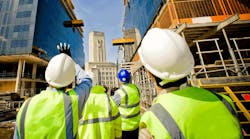I think we may start to see diminishing returns on the use of some safety equipment. If we overuse specific PPE, that PPE could reduce or diminish safety rather than increase it, as originally intended.
Many corporate safety programs stress performing a Job Hazard Analysis (JHA) for each employee. You look at the workers’ tasks and the risks involved and then determine what, if any, PPE is required. If no hazard is present, then PPE is not necessary and should not be used. For example, if no fall hazards are present, then we wouldn’t have workers walking around wearing fall harnesses. Or if there are no airborne hazards, then workers should not be required to wear respirators around the site.
With these points in mind, I’d like to question to the overuse of a specific type of PPE: the reflective safety vest.
Vest Concerns
Why is it when I look at some construction sites, I see EVERYONE on site wearing reflective safety vests? OSHA, in 29 CFR 1926.651(d), sets forth requirements for workers who are exposed to vehicular traffic. OSHA states that "employees exposed to public vehicular traffic shall be provided with, and shall wear, warning vests or other suitable garments marked with or made of reflectorized or high-visibility material."
And according to DOT, 23 CFR 634.3, Use of High-Visibility Apparel When Working on Federal-Aid Highways: “All workers within the right-of-way of a Federal-aid highway who are exposed either to traffic (vehicles using the highway for purposes of travel) or to construction equipment within the work area shall wear high-visibility safety apparel.”
These vests specifically were designed for use when there is some kind of vehicular traffic on or near the work site, or if heavy equipment such as a dozer or crane is moving around the site AND the workers will be exposed to the dangers of being struck by that traffic.
So I have to ask project managers and project safety managers, “Is there a danger of being hit by a ‘vehicle’ when employees are working on the 15th floor of a 30-story high rise building?” If not, then why are they required to wear reflective vests?
Where is the hazard?
I was recently in my office on the 10th floor and noticed electricians wearing safety vests all day long as they worked inside the building. Why was that vest required or needed?
On many job sites, the tower crane operator or the heavy equipment operator is not required to wear a hard hat while inside the cab or the piece of equipment. This makes sense since there is no danger of getting struck on the head while inside the cab. However, in most cases, these operators still are required to wear reflective safety vests. Where is the hazard for them? Can they get hit by a piece of equipment or run over while inside the cab?
If we did a JHA correctly we would have to ask if the universal use of these vests on site truly makes the workers safe. We need to ask: Does this universal donning of safety vests even when they aren’t needed increase or diminish the visual awareness for the heavy equipment operator or for the general public driving past the construction site?
It is my belief that the over use of these vests actually will diminish the safety factor that these vests originally intended for both the workers and for the general public.
Normally, when motorists drive past construction sites, they see some of the workers wearing safety vests. These vests indicate that drivers need to watch out for these workers. The workers who are out near the traffic, i.e. the flagmen, should be wearing these vests, of course. But now when drivers pass a construction site, they might see everyone on the site wearing a vest. This could take away from the driver’s awareness and reduce the safety of all workers on that site.
The over use of PPE also can affect the total site safety program. For example, workers may question why this PPE, such as the vests, are needed, and how it possibly adds to their safety. Imagine a construction site safety manager telling everyone to wear a respirator, even though it isn’t needed. What would that do to the manager’s credibility, or the credibility of the safety program?
So let’s use specific safety equipment when and only when it is needed. The safety of the site may depend on it.
John Olesky, CSP, has 30 years of experience in the safety field. He has worked in most venues including hospital safety, construction, general industry, hazardous wastes sites and general industry. Olesky is a retired Air Force Reserves bioenvironmental technician (industrial hygienist). He lives and works in Las Cruces, N.M.

